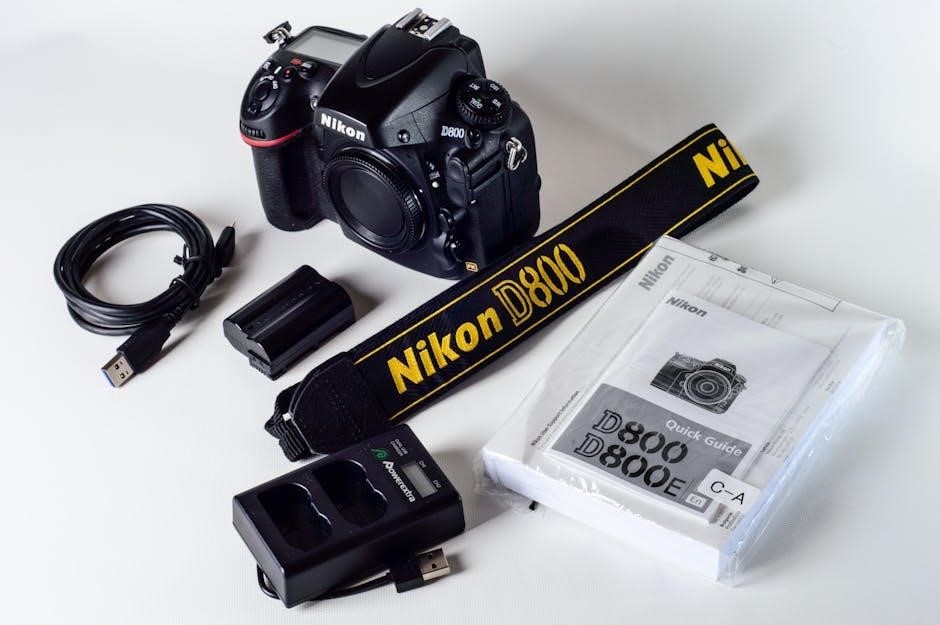Water’s unique properties, such as its molecular structure and intermolecular forces, make it essential for life and various applications․ Understanding these properties is crucial for scientific and practical uses․
Overview of Water’s Importance
Water is a cornerstone of life and the environment, playing a vital role in sustaining ecosystems and regulating Earth’s climate․ Its unique properties make it essential for biological processes, industrial applications, and agriculture․ Water’s ability to dissolve substances and regulate temperature supports life in all forms, from cellular functions to global weather patterns․ Its presence in oceans, rivers, and groundwater ensures biodiversity and ecological balance․ Additionally, water’s role in human health, energy production, and food security underscores its importance; Understanding water’s properties is crucial for addressing environmental challenges and promoting sustainable development․ Its significance extends across scientific, economic, and daily life contexts․
Key Properties of Water
Water exhibits unique properties that make it vital for life and various processes․ Its high specific heat capacity allows it to regulate temperature, while surface tension and viscosity influence its behavior in natural and industrial settings․ Water’s polarity and hydrogen bonding contribute to its exceptional solvent properties, enabling it to dissolve a wide range of substances․ Additionally, water’s chemical reactivity and ability to exist in solid, liquid, and gaseous states at Earth’s temperatures make it indispensable․ These properties collectively support biological functions, climate regulation, and ecological balance, highlighting water’s central role in sustaining life and driving environmental processes․ Its versatility underscores its importance in both natural and human-made systems․
Molecular Structure of Water
Water’s molecular structure consists of two hydrogen atoms bonded to a single oxygen atom, forming a bent shape due to unequal electron distribution, enabling hydrogen bonding․
Chemical Composition of Water
Water is composed of two hydrogen atoms and one oxygen atom, forming the chemical formula H₂O․ This simple structure is responsible for its unique properties․ The covalent bonds between oxygen and hydrogen atoms create a polar molecule, with oxygen being more electronegative․ This polarity allows water to dissolve a wide variety of substances, making it an excellent solvent․ The chemical composition of water is essential for its role in biological processes and its physical properties, such as high specific heat and surface tension․ Understanding the chemical makeup of water provides insights into its behavior in natural and industrial systems․
Hydrogen Bonding in Water
Hydrogen bonding in water occurs due to the polarity of its molecules․ Oxygen, being more electronegative, attracts electrons, creating a partial positive charge on hydrogen atoms․ This allows hydrogen atoms from one water molecule to form weak electrostatic bonds with oxygen atoms in adjacent molecules․ These bonds are relatively strong compared to other intermolecular forces, giving water unique properties like high specific heat and surface tension․ Hydrogen bonding is also responsible for water’s ability to dissolve various substances and its role in biological processes․ This molecular interaction is crucial for maintaining water’s liquid state at Earth’s temperatures and its ability to regulate climate․
Physical Properties of Water
Water exhibits unique physical properties, including high specific heat, surface tension, and viscosity, which contribute to its essential role in biological and environmental systems․
High Specific Heat Capacity

Water has a high specific heat capacity, meaning it absorbs and releases significant heat without drastic temperature changes․ This property stabilizes Earth’s climate, moderating weather patterns and preventing extreme temperature fluctuations․ Oceans act as massive heat reservoirs, absorbing solar energy during the day and releasing it at night, maintaining environmental balance․ This characteristic also influences cooking and heating processes, as water can distribute heat evenly․ Its specific heat capacity is approximately 1 calorie per gram per degree Celsius, higher than many other substances, making it a crucial factor in regulating ecosystems and supporting life on Earth․
Surface Tension of Water
Surface tension is a property of water caused by hydrogen bonding, creating a “skin” on its surface․ This tension allows water to resist external forces, enabling insects to walk on water and droplets to form beads․ It is highest in pure water and decreases with impurities or heat․ Surface tension plays a role in capillary action, plant water transport, and biological processes like cell membrane stability․ This property is essential for many natural phenomena and industrial applications, showcasing water’s unique behavior at its surface․ Understanding surface tension helps explain various physical and biological interactions in ecosystems and everyday life․
Viscosity of Water
Viscosity of water refers to its resistance to flow, influenced by hydrogen bonding and molecular interactions․ At 20°C, water’s viscosity is approximately 0․001002 Pa·s, allowing it to flow easily․ Viscosity decreases with temperature, becoming less viscous as it heats up․ This property affects fluid dynamics, biological processes, and industrial applications․ In living organisms, water’s low viscosity enables efficient blood circulation and cellular transport․ In engineering, understanding viscosity is crucial for systems involving water flow, such as cooling systems and irrigation․ Water’s viscosity balances between being fluid enough for movement and thick enough to maintain structural integrity in various natural and man-made systems․
Thermal Properties of Water
Water exhibits high specific heat, heat of vaporization, and thermal conductivity, enabling it to regulate temperatures and transfer heat efficiently in natural and industrial systems․
Heat of Vaporization
Water’s high heat of vaporization, approximately 40․65 kJ/mol, signifies the substantial energy required to transition from liquid to gas․ This property plays a critical role in regulating Earth’s climate by absorbing and releasing heat, moderating temperature extremes․ It also influences weather patterns and the water cycle, as it affects evaporation rates and cloud formation․ The high energy demand for vaporization helps maintain Earth’s energy balance, preventing rapid temperature fluctuations․ This property is essential for life, enabling cooling mechanisms like sweating and maintaining atmospheric humidity․ Understanding heat of vaporization is vital for climate modeling and industrial applications involving water phase changes․

Latent Heat of Fusion
Water’s latent heat of fusion, approximately 334 J/g, represents the energy required to melt ice at 0°C into liquid water without temperature change․ This property is crucial for climate regulation, as it absorbs significant energy during melting, moderating temperature shifts․ It influences processes like glacier formation and sea ice dynamics, impacting global weather patterns․ In everyday applications, latent heat of fusion is harnessed in ice-making systems and thermal energy storage․ Its high value ensures stability in ecosystems, preventing rapid environmental changes․ Understanding this property aids in predicting ice melt rates and its effects on Earth’s hydrological cycle and biodiversity․
Thermal Conductivity
Water exhibits moderate thermal conductivity, approximately 0․6 W/m·K at 20°C, meaning it can transfer heat efficiently compared to other liquids․ This property is influenced by its molecular structure and hydrogen bonding, which facilitate energy transfer․ Thermal conductivity plays a key role in natural processes, such as heat distribution in oceans, and in industrial applications like cooling systems․ It ensures temperature regulation in ecosystems and affects climate patterns by redistributing heat globally․ Understanding water’s thermal conductivity is vital for engineering and environmental studies, as it impacts both technological designs and Earth’s climate system․ Its ability to conduct heat efficiently makes it a unique and essential resource․
Density and Buoyancy
Water’s density varies with temperature, reaching maximum density at 4°C․ This property influences buoyancy, affecting how objects float or sink, and is crucial in aquatic ecosystems and engineering applications․
Density Variations with Temperature
Water’s density changes with temperature, reaching its maximum at 4°C․ This unique behavior causes water to expand when freezing, making ice less dense than liquid water․ Unlike most substances, water’s density decreases as it cools below 4°C, leading to ice floating on water․ This property is crucial for aquatic ecosystems, as it prevents lakes and rivers from freezing solid․ The density variation also affects buoyancy and heat transfer in water systems․ Understanding this behavior is essential for environmental science, engineering, and predicting water’s physical responses in different thermal conditions․ This characteristic is a key factor in many natural and industrial processes․
Buoyancy and Flotation
Buoyancy and flotation are phenomena governed by water’s density and pressure differences․ Objects float when their density is less than water’s, displacing a volume of water equal to their weight․ Water’s unique property of expanding when freezing reduces ice’s density, allowing it to float․ This buoyancy supports aquatic life and affects ocean currents․ Ships and boats utilize this principle to stay afloat, while submerged objects rely on water’s pressure increasing with depth․ Understanding buoyancy is vital for engineering, marine biology, and environmental studies, as it influences ecosystems and climate regulation․ Water’s density variations with temperature further enhance its buoyant properties, making it a dynamic medium for flotation and fluid motion․

Chemical Properties of Water
Water exhibits unique chemical properties, including polarity, solubility, and reactivity, making it a universal solvent․ Its ability to form hydrogen bonds enhances its chemical interactions and biological roles․
Polarity and Solubility
Water’s polarity arises from its bent molecular structure, with oxygen being more electronegative than hydrogen․ This polarity allows water to form hydrogen bonds, making it a versatile solvent․ Its ability to dissolve a wide range of substances is due to its polar nature, which enables it to interact with both ionic and polar compounds․ This property is essential for chemical reactions and biological processes, as it facilitates the transport of nutrients and waste in living organisms․ Additionally, water’s solubility plays a critical role in maintaining ecological balance and supporting industrial applications, making it indispensable in various natural and human-made systems․
pH and Acidity
Water’s pH indicates its acidity or basicity, with pure water being neutral at pH 7․ This neutrality results from water’s self-ionization, where it produces equal amounts of hydrogen (H⁺) and hydroxide (OH⁻) ions․ The pH scale measures the concentration of hydrogen ions, influencing chemical reactions and biological processes․ Water’s ability to maintain a balanced pH is crucial for its role as a solvent and in regulating chemical equilibria․ Changes in pH affect water’s acidity, impacting its interactions with substances and its suitability for various applications, from industrial processes to biological systems․ Understanding pH is essential for analyzing water quality and its chemical behavior․
Chemical Reactivity
Water exhibits unique chemical reactivity due to its polar nature and ability to form hydrogen bonds․ Its polarity allows it to dissolve a wide variety of substances, making it an excellent solvent․ Water can ionize slightly, producing hydrogen (H⁺) and hydroxide (OH⁻) ions, which facilitate chemical reactions․ It reacts with metals like sodium, releasing hydrogen gas, and with acids, bases, and salts, influencing pH levels․ Water’s reactivity is also evident in its role in hydrolysis and redox reactions, where it acts as both a reactant and a product․ These properties make water a versatile and dynamic substance in chemical processes, essential for both natural and industrial applications․

Biological Properties of Water
Water’s biological properties are vital for life, serving as a solvent, regulating temperature, and facilitating metabolic processes in living organisms․ Its unique structure supports cellular functions and ecosystems․
Role in Biological Processes
Water plays a central role in biological processes, serving as a medium for chemical reactions and maintaining cellular homeostasis․ Its high specific heat regulates temperature fluctuations, essential for enzyme function and metabolic stability․ Water’s solvent properties dissolve nutrients, hormones, and waste products, enabling their transport within organisms․ It facilitates photosynthesis in plants and aids in digestion and nutrient absorption in animals․ Additionally, water participates in cellular respiration and the transport of oxygen and carbon dioxide․ Its role in maintaining cell turgidity and structural integrity is vital․ Without water, life as we know it would cease to function, highlighting its indispensable role in sustaining biological systems․
Water as a Solvent in Living Organisms
Water’s polarity and hydrogen bonding enable it to dissolve a wide variety of substances, making it an exceptional solvent in living organisms․ This property facilitates the transport of nutrients, hormones, and oxygen throughout the body․ In cells, water dissolves enzymes, ions, and other biomolecules, allowing biochemical reactions to occur efficiently․ It also aids in the removal of waste products through processes like urination and perspiration․ Without water’s solvent capabilities, the exchange of essential materials and energy within cells would be impossible, underscoring its critical role in maintaining life and enabling metabolic processes to function smoothly․
Water in Cellular Functions
Water plays a central role in cellular functions, serving as a medium for chemical reactions and the transport of essential nutrients․ It facilitates enzyme activity, protein folding, and the breakdown of nutrients for energy production․ Additionally, water helps maintain cell shape and turgidity by providing structural support․ Its high specific heat capacity also regulates temperature fluctuations within cells, ensuring stable conditions for metabolic processes․ Without water, cellular functions like DNA replication, protein synthesis, and waste removal would be severely impaired․ Its versatility and unique properties make water indispensable for sustaining life and enabling cells to operate efficiently․
Environmental Properties of Water
Water’s environmental properties, such as its role in the water cycle and climate regulation, are vital for sustaining ecosystems and weather patterns, ensuring life on Earth․
Water Cycle and Circulation
The water cycle, also known as the hydrologic cycle, is the continuous process by which water circulates through the Earth and atmosphere; It involves evaporation, condensation, and precipitation, with water moving between oceans, lakes, rivers, and the atmosphere․ This process is driven by solar energy and gravity, ensuring the distribution of water across the globe․ Water circulation plays a critical role in regulating Earth’s climate, influencing weather patterns, and sustaining ecosystems․ Understanding the water cycle is essential for managing water resources and addressing environmental challenges, as it highlights the interconnectedness of water in all its forms and environments․

Role in Ecosystems
Water plays a vital role in ecosystems, serving as a universal solvent and medium for chemical reactions․ It regulates Earth’s climate, moderates temperatures, and supports biodiversity․ Ecosystems rely on water for nutrient transport, photosynthesis, and sustaining aquatic life․ Its high specific heat capacity stabilizes environmental conditions, while surface tension and viscosity influence habitat structures․ Water’s properties enable it to act as a coolant, lubricant, and reactant, essential for metabolic processes․ Ecosystems depend on water’s availability and quality, making it a cornerstone of life and ecological balance․ Its role in shaping landscapes and weather patterns further underscores its importance in maintaining Earth’s natural systems and processes․
Impact of Water on Climate
Water significantly influences Earth’s climate through its unique properties․ Its high specific heat capacity stabilizes temperatures, absorbing and releasing heat slowly․ Water’s latent heat of vaporization facilitates energy transfer during evaporation and condensation, driving weather patterns․ The water cycle, powered by evaporation and precipitation, distributes heat globally․ Surface tension and viscosity affect ocean currents, which regulate regional climates; Water’s role in forming clouds and precipitation further modulates temperature and weather systems․ Its polarity enhances solvent properties, influencing atmospheric chemistry․ Overall, water’s properties are central to climate regulation, making it a key factor in shaping Earth’s weather and climate systems․

Applications of Water’s Properties
Water’s properties drive industrial processes, agricultural irrigation, and domestic uses․ Its high specific heat and surface tension enable cooling systems and cleaning agents, while viscosity aids fluid dynamics․
Industrial Uses of Water
Water’s unique properties make it indispensable in industries․ Its high specific heat capacity is used in cooling systems, while surface tension aids in cleaning agents․ Viscosity plays a role in fluid dynamics, enabling efficient transportation of materials․ Industries like power plants, manufacturing, and laboratories rely on water for processes, cooling, and cleaning․ Its chemical properties facilitate reactions and solubility, making it a versatile solvent․ Additionally, water’s density and buoyancy are harnessed in hydraulic systems and material separation․ These applications highlight water’s critical role in maintaining industrial operations and driving technological advancements across various sectors․
Agricultural Applications
Water’s properties are vital in agriculture, where its high specific heat regulates soil temperature, protecting crops from extreme fluctuations․ Surface tension aids in efficient irrigation, ensuring water reaches plant roots․ Polarity and solubility make water an excellent solvent for fertilizers and pesticides, enhancing nutrient delivery․ Its role in photosynthesis and plant growth is irreplaceable․ Additionally, water’s viscosity and density support hydroponic systems, while its cooling properties are used in livestock facilities․ These applications underscore water’s essential role in sustaining agricultural productivity and food security, making it a cornerstone of farming practices worldwide․
Domestic and Household Uses
Water’s unique properties make it indispensable in domestic settings․ Its high specific heat helps regulate indoor temperatures, while surface tension aids in cleaning by allowing water to spread evenly on surfaces․ Polarity enhances its solvent properties, making it effective for washing and dissolving detergents․ In cooking, water’s heat capacity ensures even temperature distribution, preventing rapid food burning․ Additionally, its viscosity and flow properties facilitate efficient plumbing systems․ Water’s role in hygiene, from bathing to waste removal, underscores its importance in maintaining health and cleanliness․ These everyday applications highlight how water’s properties contribute to comfort and convenience in household environments, making it an essential resource․

Measurement and Analysis of Water Properties
Water properties are measured using methods like calorimetry for specific heat and tensiometers for surface tension, ensuring accurate analysis of its physical and chemical characteristics․
Methods for Measuring Specific Heat
Calorimetry is the primary method for measuring water’s specific heat capacity․ This involves heating a known mass of water and recording the temperature change․ The heat absorbed by water is calculated using the formula: Q = mcΔT, where m is mass, c is specific heat, and ΔT is the temperature change․ Modern calorimeters use thermometers and sensors for precise measurements․ This method helps determine how water absorbs and releases heat, crucial for understanding its role in thermal regulation․ Accurate measurements are essential for scientific and industrial applications, showcasing water’s unique ability to stabilize temperatures in various systems․

Techniques for Analyzing Surface Tension
Surface tension in water is typically measured using the drop weight method or capillary rise technique․ The drop weight method involves measuring the volume of water droplets falling from a needle, while capillary rise observes the height water reaches in a narrow tube․ Modern tools like tensiometers and contact angle analyzers provide precise measurements․ These techniques help understand water’s ability to resist external forces at its surface, a property influenced by hydrogen bonding․ Analyzing surface tension is crucial for studying water’s behavior in biological systems and industrial applications, such as cleaning and material science․ Accurate measurements reveal water’s unique intermolecular forces․
Laboratory Tests for Water Quality
Laboratory tests for water quality assess physical, chemical, and biological properties․ Common tests include measuring pH levels, turbidity, and dissolved oxygen․ Bacterial contamination is checked using tests for E․ coli and total coliforms․ Chemical tests detect heavy metals, nitrates, and pesticides․ Physical tests evaluate temperature, conductivity, and hardness․ These analyses ensure water safety for drinking, irrigation, and industrial use․ Advanced techniques like spectroscopy and chromatography provide detailed insights․ Regular testing helps monitor pollution levels and maintain environmental standards, ensuring water resources remain sustainable and safe for ecosystems and human consumption․ Accurate laboratory results are essential for regulatory compliance and public health protection․






























